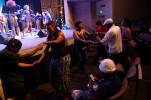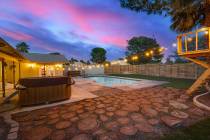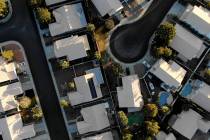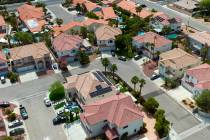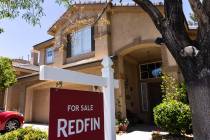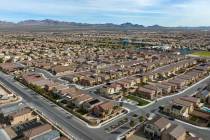Midyear real-estate report says gains in home values abound

To hear people whine about the Las Vegas housing market, you’d think they were cats taking a bath.
Sure, home prices have receded from their all-time peak, which was just a year ago and followed a period of blistering appreciation. Las Vegas led the nation with quarterly appreciation of 40 percent and 50 percent in 2004.
Increased housing demand from mid-2003 through 2005 resulted in record numbers in both the new and resale home market, Coldwell Banker Premier Realty President Bob Hamrick said.
The market has backed off, but the gains remain, he said.
Nine ZIP codes in Las Vegas Valley with depreciating home values in 2006 show net gains of anywhere from 9 percent to 81 percent since 2003, according to a midyear report from Coldwell Banker Premier Realty.
One sample neighborhood gained 16 percent in 2003, 45 percent in 2004 and 13 percent in 2005, appreciating more in three years than it would have in 20 years by historical standards.
Before 1999, Las Vegas was among the slower U.S. housing markets with annual appreciation of 1 percent to 4 percent. That’s what made it one of the best housing values in the nation. Homes in master-planned Summerlin were selling for $66 a square foot at a time when a comparable home in Phoenix was selling for $115 to $120 a square foot.
Giving back 1 percent last year is a drop in the bucket, Hamrick said.
“Few of us would pass on a stock market investment with a three-year return on investment of 73 percent,” he said. “With the onslaught of negative press, many of us have forgotten about these record-breaking gains.”
Two of the three worst-performing ZIP codes in 2006 have had a price increase and two areas had an equal or higher number of sales.
ZIP code 89044, near Henderson Executive Airport, has an average sales price of $386,135 this year, compared with $381,209 in 2006. The high-end west Summerlin neighborhood of 89135 saw a slight increase from $654,620 to $656,320. In the 89084 area of Aliante in North Las Vegas, prices declined from $330,971 to $314,103.
ZIP code 89086, a new area of North Las Vegas, had the lowest net gain of more than 50 ZIP codes in the valley at 9 percent for the 12-month period from 2005 to 2006. Before 2003, 9 percent appreciation for 12 months would have been exceptional, Hamrick said.
Larry Murphy, president of SalesTraq, said he compared first-half prices of 2007 to first-half 2006 at his midyear housing outlook and every area was negative.
“Everybody is whining and crying in their soup about the market being down and they’re losing equity in their home. That’s true for the last 12 months,” Murphy said.
He compared home prices in master-planned communities from 2003 to 2007 and found that average appreciation was 68 percent. Spanish Trail had the greatest appreciation at 93 percent.
Hamrick noted that some areas of the valley depreciated by as much as 16 percent in 1984, making last year’s 4 percent depreciation in 89044 seem trivial by comparison.
Home prices have risen so high in Las Vegas that the city is now ranked among the 10 least-affordable U.S. real estate markets by Forbes.com. Los Angeles is No. 1, followed by San Francisco, San Diego, New York, Miami, Sacramento, Calif., and Las Vegas. Rounding out the top 10 are Seattle, Boston and Orlando, Fla.
Affordability has a great deal to do with where a city is in its growth cycle.
“Five years ago, Las Vegas was one of the nation’s most affordable cities, thanks to a rash of development,” Forbes.com reported. “Today, growth has slowed enough that less than 20 percent of home sales last quarter were available to households at the median income level.”
The median price of a “traditional” new home in Las Vegas, excluding high-rise and mid-rise condos and apartment conversions, was $314,551 in July, down 6.2 percent from a year ago, Dennis Smith of Home Builders Research reported.
With the number of homes on the market topping 30,000, including condos and townhomes, absorption rates have increased and will continue to do so until homeowners, banks and mortgage companies adjust to the importance that list price is playing in this market, Hamrick said.
The inventory of homes in the $150,000 to $250,000 range was absorbed in 2.3 months in 2006; in 2007, it’s 10.5 months. Home inventory in the $250,000 to $400,000 range took 5.8 months to sell in 2006; now it’s 10.8 months. Absorption of $400,000 to $600,000 homes went from 9.2 months last year to 15.1 months this year.
About one out of every 16 homes that come on the market will sell, Hamrick said. Some of them are only on the market for a few days or a few weeks.
“These are the properties in the best condition and priced correctly with little or no room for negotiation,” he said. “Houses are still selling, but we have to be realistic about what other units have sold for. Frankly, most appraisers are looking at only the last two or three months. In some neighborhoods, we have sellers who are willing to price below comparables.”
Murphy of SalesTraq said Las Vegas has a 15.3-month supply of homes by his count. Supply continues to go up as it has for the last two years and prices have been gently sliding, an indication that the housing market has not yet reached bottom, he said.
Price is one factor in home sales, but it’s not the only factor, Hamrick said. With all these homes on the market, buyers can choose from a selection of 10 to 20 homes, not two or three, so “staging,” or presenting the home for sale, is critical, he said.
Housing in Las VegasMore Information



